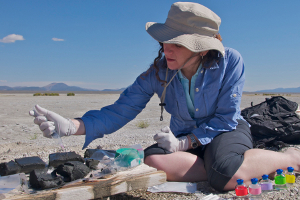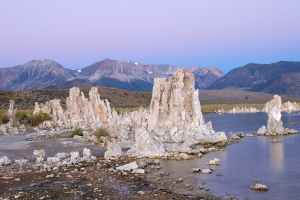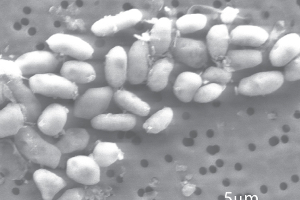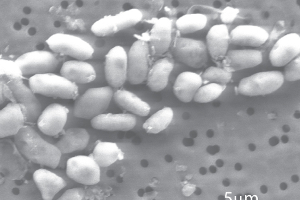“As someone who regularly gives lectures in which I state, ‘every living thing uses phosphorus to build its DNA’, the idea that I’m sitting here today discussing the possibility that that’s not true is quite shocking,” said James Elser, a professor at Arizona State University who participated in a NASA teleconference convened today to discuss the findings.
The discovery of the arsenic-loving microbe also “opens new doors” to explore what life may look like in other reaches of the solar system, on environments such as Mars or the moons of Jupiter and Saturn that have previously been thought to be too cold and harsh to support life.
 Felicia Wolfe-Simon of the NASA Ames Research Center and USGS collects samples from a sediment core extracted from the shores of Mono Lake in eastern California. (Credit: Henry Bortman)
Felicia Wolfe-Simon of the NASA Ames Research Center and USGS collects samples from a sediment core extracted from the shores of Mono Lake in eastern California. (Credit: Henry Bortman)
“We still don’t know everything there is to know about what might make a habitable environment on another planet or a satellite of another planet,” said Pamela Conrad, an astrobiologist at NASA’s Goddard Space Flight Center in Greenbelt, Maryland. “Perhaps arsenic is not an essential component for habitability or life but it may be one that can be tolerated and it opens our perspective to try and understand what other potential components may be tolerated or perhaps even essential that we presently haven’t thought of,” she added.
A paper describing the finding appears in this week’s edition of the journal Science Express.
But before the embargo on the paper was lifted on Thursday, a flurry of speculation was set off earlier in the week that NASA had discovered proof of alien life, fueled by an ambiguous press release issued by NASA on Monday which trumpeted “an astrobiology finding that will impact the search for evidence of extraterrestrial life.” In fact, the embargo was lifted roughly two hours earlier than planned because reports of the finding, some of them erroneous, were already beginning to appear online in publications like The Huffington Post and the Guardian.
At the end of NASA’s Thursday teleconference, Mary Voytek, director of the Astrobiology Program at NASA headquarters in Washington, D.C. responded to a question from a USA Today journalist about the disappointment felt by its readers that in fact, NASA would not be pulling E.T out of a hat.
“I guess what I would say is that while being able to announce the discovery of an extra-terrestrial would be an incredible announcement, from our perspective, this is a phenomenal finding. It will require some paragraphs in textbooks to be rewritten,” said Voytek. “It will fundamentally change how we define life and how we look for it, maybe we’ll be able to find E.T. now because we’ve got more information about what we might be looking for,” she added.
The research team, led by Wolfe-Simon, discovered the new strain of bacteria, GFAJ-1, in muddy sediment cores extracted from the shores of Mono Lake, located in eastern California, near the Sierra Nevada mountains. The 70 square-mile inland lake is highly salty and alkaline with high concentrations of naturally-occurring arsenic. It has been separated from freshwater for 50 years and teems with brine shrimp and algae. It also serves as a major stop-over point for migratory birds.
Wolfe-Simon chose to investigate how GFAJ-1 responded to arsenic because of the toxic compound’s chemical similarity to phosphorus. She pointed out that arsenic lies just below phosphorus on the periodic table and that their atoms are roughly the same in size. But arsenic is highly toxic to most living organisms because it disrupts metabolic pathways in the cells which take up arsenic readily, given its chemical similarity to phosphorus.
So Wolfe-Simon took the muddy samples containing the bacteria and grew them in petri dishes in a watery solution containing sugar and high levels of arsenic, while reducing the amount of phosphate salt the bacteria were fed. Eventually, the bacteria were fed only a diet of arsenic.
“It grew and it thrived, and this was amazing. Nothing should have grown,” said Simon.
In just six days, the bacteria multiplied twenty-fold as it wolfed down the arsenic.
Simon and her colleagues used radiolabeled arsenate, a form of arsenic, to track the movement of arsenic inside the bacteria. With the aid of additional laboratory techniques, they found that the bacteria’s cellular machinery of lipids, proteins, even its DNA, were now made up of arsenic. So the bacteria were able to fully substitute phosphorus, which provides the chemical backbone of DNA, for arsenic and still function and grow just fine.
 Mono Lake, located in eastern California, next to the Sierra Nevada mountains, is highly saline and has high concentrations of arsenic. (Credit: Henry Bortman)
Mono Lake, located in eastern California, next to the Sierra Nevada mountains, is highly saline and has high concentrations of arsenic. (Credit: Henry Bortman)
"We know that some microbes can breathe arsenic, but what we've found is a microbe doing something new -- building parts of itself out of arsenic," said Wolfe-Simon.
And according to Professor Elser at Arizona State University, the discovery of a microbe that thrives on arsenic may have value beyond the lab and academic papers. Elser mused on the possibility of using GFAJ-1 to clean up naturally-occurring arsenic, which can pollute groundwater and lead to failure of organs such as the kidneys and liver if ingested.
Then there’s the burgeoning field of biofuels, the next generation of which include algae. But algae and other plants being cultivated for renewable fuels require phosphorus to grow.
“So what if someone was clever enough to be able to develop a bioenergy creature, a microorganism, based on this metabolism that doesn’t need phosphorus, so you don’t need to drain the fertilizer supply in order to solve the bioenergy problem,” said Elser. “It’s pretty exciting to think about the possibility of organisms that may be able to live without phosphorous,” he added.
For Felisa Wolfe-Simon, the discovery of the arsenic-loving bacteria is an important milestone in astrobiology, a discipline which combines chemistry, astronomy, biology and other sciences to understand the evolution of life and the future of life – on Earth and beyond.
“We’ve cracked open the door to what’s possible for life elsewhere in the universe and that’s profound and to understand how life has formed and where life is going,” she said. “And what else might we find, what else might we want to look for?”
 Scanning electron microscope image of the arsenic-loving bacteria GFAJ-1. (Credit: AAAS/Science)
Scanning electron microscope image of the arsenic-loving bacteria GFAJ-1. (Credit: AAAS/Science) 

